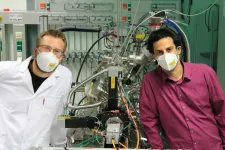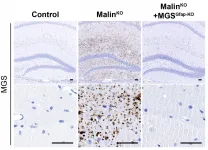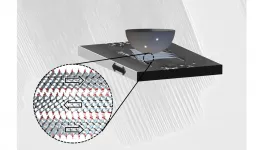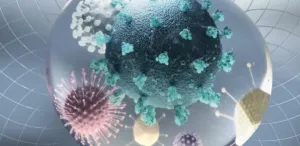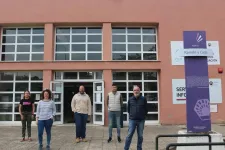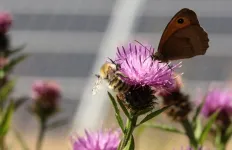(Press-News.org) If the CO2 content of the atmosphere is not to increase any further, carbon dioxide must be converted into something else. However, as CO2 is a very stable molecule, this can only be done with the help of special catalysts. The main problem with such catalysts has so far been their lack of stability: after a certain time, many materials lose their catalytic properties.
At TU Wien, research is being conducted on a special class of minerals - the perovskites, which have so far been used for solar cells, as anode materials or electronic components rather than for their catalytic properties. Now scientists at TU Wien have succeeded in producing a special perovskite that is excellently suited as a catalyst for converting CO2 into other useful substances, such as synthetic fuels. The new perovskite catalyst is very stable and also relatively cheap, so it would be suitable for industrial use.
How to close the carbon cycle
"We are interested in the so-called reverse water-gas shift reaction," says Prof. Christoph Rameshan from the Institute of Materials Chemistry at TU Wien. "In this process, carbon dioxide and hydrogen are converted into water and carbon monoxide. You can then process the carbon monoxide further, for example into methanol, other chemical base materials or even into fuel."
This reaction is not new, but it has not really been implemented on an industrial scale for CO2 utilisation. It takes place at high temperatures, which contributes to the fact that catalysts quickly break down. This is a particular problem when it comes to expensive materials, such as those containing rare metals.
Christoph Rameshan and his team investigated how to tailor a material from the class of perovskites specifically for this reaction, and he was successful: "We tried out a few things and finally came up with a perovskite made of cobalt, iron, calcium and neodymium that has excellent properties," says Rameshan.
Atoms migrating through the crystal
Because of its crystal structure, the perovskite allows certain atoms to migrate through it. For example, during catalysis, cobalt atoms from the inside of the material travel towars the surface and form tiny nanoparticles there, which are then particularly chemically active. At the same time, so-called oxygen vacancies form - positions in the crystal where an oxygen atom should actually sit. It is precisely at these vacant positions that CO2 molecules can dock particularly well, in order to then be dissociated into oxygen and carbon monoxide.
"We were able to show that our perovskite is significantly more stable than other catalysts," says Christoph Rameshan. "It also has the advantage that it can be regenerated: If its catalytic activity does wane after a certain time, you can simply restore it to its original state with the help of oxygen and continue to use it."
Initial assessments show that the catalyst is also economically promising. "It is more expensive than other catalysts, but only by about a factor of three, and it is much more durable," says Rameshan. "We would now like to try to replace the neodymium with something else, which could reduce the cost even further."
The industrial plant with built-in fuel production
Theoretically, you could use such technologies to get CO2 out of the atmosphere - but to do that you would first have to concentrate the carbon dioxide, and that requires a considerable amount of energy. It is therefore more efficient to first convert CO2 where it is produced in large quantities, such as in industrial plants. "You could simply add an additional reactor to existing plants that currently emit a lot of CO2, in which the CO2 is first converted into CO and then processed further," says Christoph Rameshan. Instead of harming the climate, such an industrial plant would then generate additional benefits.
INFORMATION:
Contact
Prof. Christoph Rameshan
Institut of Materials Chemistry
TU Wien
+43 1 58801 165115
christoph.rameshan@tuwien.ac.at
As we accumulate more and more gene-sequencing information, cell-type databases are growing in both size and complexity. There is a need to understand where different types of cells are located in the body, and to map their gene expression patterns into specific locations in tissues and organs. For example, a gene can be actively expressed in one cell while suppressed in another.
One way of mapping genes into tissues is a technique called in situ hybridization. Simply put, a target gene is tagged ("hybridized") with a fluorescent marker within the sections of the tissue it is located in (the "in situ" part). The sections are then visualized under a specialized microscope to see where the gene "lights up". Consecutive photographs of each section are then put together to generate a ...
Lafora disease is an inherited neurodegenerative condition that initially develops with seizures in adolescence and evolves with progressive degeneration of the nervous system to death, about ten years after its onset. It is characterised by the accumulation of abnormal glycogen aggregates called Lafora bodies in the brain. There is currently no treatment for this condition, although some therapies are being tested in clinical trials.
Led by Dr. Joan Guinovart, emeritus professor of the University of Barcelona (UB) and also group leader of CIBERDEM, the Metabolic Engineering lab at IRB Barcelona has discovered that Lafora bodies that accumulate in glial cells, which are essential for the proper ...
You can lubricate a bicycle chain with oil, but what do you do with a Mars rover or a red-hot conveyor belt in the steel industry? Very special nanomaterials have now been studied by the TU Wien together with research groups from Saarbrücken (Germany), Purdue University in the USA and the Universidad de Chile (Santiago, Chile).
The material class of MXenes (pronounced "maxene") has caused quite a stir in recent years in connection with novel battery technologies. But it now turns out that they are also an excellent solid lubricant that is extremely durable and performs its task even under the most difficult conditions. These remarkable properties of MXenes have now been published in the renowned journal ACS Nano.
Like a stack of sheets of paper
Just ...
A new type of COVID-19 testing strategy could help streamline the process of identifying cases, tracking variants and detecting co-infecting viruses.
At present, separate assays and complex workflows are involved in each of these three diagnostic procedures, with analyses typically performed in highly specialized facilities. KAUST researchers have now combined all three kinds of tests into a single procedure that should allow for point-of-care tracking of COVID-19 and the many emerging variants of SARS-CoV-2.
"Our all-in-one test provides a promising integrated solution for rapid field-deployable detection and mutational surveillance of pandemic viruses," says stem cell biologist Mo Li, who led the study.
The test involves a portable ...
Scrobiculariaplana is a type of wedge clam widely found along the coasts and estuariesof northern Europe, the Mediterranean and West Africa. Like other mollusks, it is used as a bioindicator to study pollution in these types of ecosystems, for its ability to accumulate heavy metals and organic pollutants.
A new study has managed to identify the transcriptome and the associated proteome of this bivalve, a finding that could represent an important leap forward in the early detection of pollutants in coastal areas. While the genome is the DNA content comprising the genetic information essential for life, the transcriptome includes only the information on genes that are expressed, while the proteome is the totality of proteins expressed at a given time and under specific conditions. Therefore, ...
Frequent use of social media may not amount to the same as addiction, according to research at the University of Strathclyde.
The study invited 100 participants to locate specific social media apps on a simulated smartphone screen as quickly and accurately as possible, while ignoring other apps. The participants were varied in the extent and type of their social media use and engagement.
The exercise aimed to assess whether social media users who reported the greatest level of use were more likely to have their attention drawn to the apps through a process known as 'attentional bias,' ...
Researchers assessing the impact of solar energy development across Europe have come up with ten ways in which the expansion of solar can be shaped to ensure pollinators benefit.
Space-hungry solar photovoltaic (PV) is set to dominate future global electricity supply, but with careful decision making, efforts to secure clean energy need not come at the expense of biodiversity - particularly pollinators which are in sharp decline.
Bees, hoverflies, wasps, beetles, butterflies and moths play a key role in food production, with around 75% of the leading global food crops and 35% of global crop production relying on them to some extent.
Writing in the journal Renewable and Sustainable Energy Reviews, a Lancaster-led team of environmental scientists systematically reviewed the available ...
KINGSTON, R.I., -- April 20, 2021 -- The Northwest Atlantic Shelf is one of the fastest-changing regions in the global ocean, and is currently experiencing marine heat waves, altered fisheries and a surge in sea level rise along the North American east coast. A END ...
Almost 80% of South Africans speak one of the SEB family languages as their first language. Their origins can be traced to farmers of West-Central Africa whose descendants over the past two millennia spread south of the equator and finally into Southern Africa.
Since then, varying degrees of sedentism [the practice of living in one place for a long time], population movements and interaction with Khoe and San communities, as well as people speaking other SEB languages, ultimately generated what are today distinct Southern African languages such as isiZulu, isiXhosa and Sesotho.
Despite these linguistic differences, ...
The Cyclostomata is an ancient group of aquatic colonial suspension-feeders from the phylum Bryozoa. The fact that they have unique placentae has been discovered by researchers at St Petersburg University and the University of Vienna. The coenocytes, i.e. large multinucleate cell structures, originate via nuclear multiplication and cytoplasmic growth among the cells surrounding the early embryo. Interestingly, the coenocytes are commonly found among fungi and plants, yet are quite rare in animals. It is the first time coenocytes have been discovered in placenta.
Biologists are well aware that the cells of the living organisms are incredibly different in the way that they behave. They may happen to form a ...
